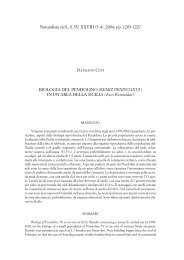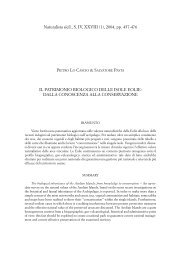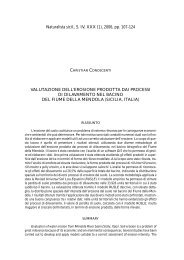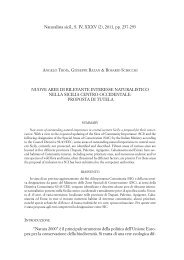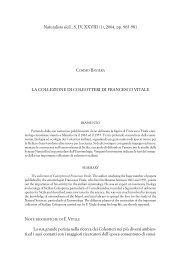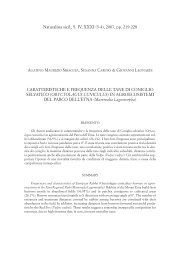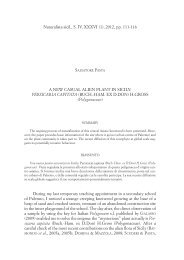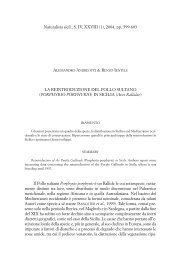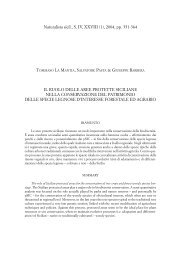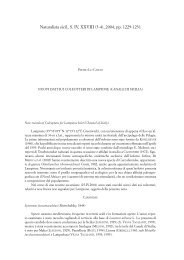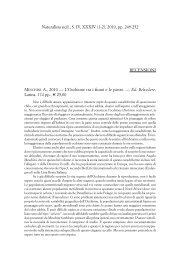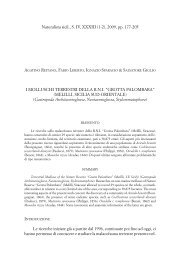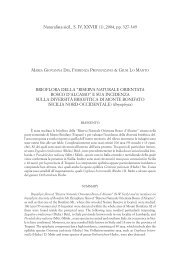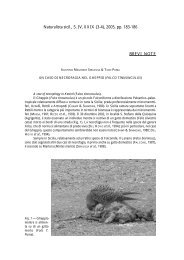2007,pp - Società Siciliana di Scienze Naturali
2007,pp - Società Siciliana di Scienze Naturali
2007,pp - Società Siciliana di Scienze Naturali
You also want an ePaper? Increase the reach of your titles
YUMPU automatically turns print PDFs into web optimized ePapers that Google loves.
Gall midges (Diptera Cecidomyiidae) of Sicily<br />
283<br />
jection and a flat, hard cone with a small projection at its tip (Pl. I, Fig. 7).<br />
Biology is similar to that of Janetia cerris. Occurrence: DE STEFANI (1907a)<br />
reported galls of J. homocera found on leaves of Quercus lineata Bl. cultivated<br />
within the Botanical Garden of Palermo, originating from Khasia in Greece.<br />
Galls of J. homocera have been recently collected on leaves of Quercus cerris<br />
at S. Alfio (Etna), 29.9.2004, leg. T. La Mantia. Distribution: Me<strong>di</strong>terranean.<br />
Janetiella euphorbiae De Stefani, 1907<br />
Larvae cause galls at vegetative tips of Euphorbia characias L. (formerly<br />
Euphorbia wulfenii Ho<strong>pp</strong>e ex Koch.) (Euphorbiaceae). The gall consists of<br />
several small leaves changed as rosette-like and larvae develop among them.<br />
Occurrence: DE STEFANI (1906c, 1907b, 1908a) rarely found galls on Mts.<br />
Renda, Monreale (600 m) in October and November, reared adults and<br />
described the species. This kind of gall on Euphorbia characias has been found<br />
some times in autumn on Nature Reserve Zingaro (Trapani) (leg. B. Massa),<br />
but no adults emerged. Reference: GAGNÉ (1990), SOLINAS & PECORA (1984).<br />
Distribution: Me<strong>di</strong>terranean.<br />
Janetiella oenephila (Haimhoffen, 1875)<br />
Cecidomyia oenephila Haimhoffen, 1875<br />
Syn. Janetiella oenophila Kieffer, 1913: misspelling of oenephila<br />
Larvae cause small rounded galls on leaves of Vitis vinifera L. (Vitaceae),<br />
which are usually located near the leaf veins (Pl. V, Figs. 28 and 29). Fully<br />
grown larvae leave galls, fall to the soil where they overwinter. Only one generation<br />
develops a year. Occurrence: DE STEFANI (1899, 1905a, 1906c) found<br />
in August galls near Palermo, Catania, Agrigento, Trapani and Messina and<br />
reared several species of parasitoids. Distribution: Me<strong>di</strong>terranean, reaching<br />
up Turkey (SKUHRAVÁ et al., 2005).<br />
Note: DE STEFANI (1906c, page 92) mentioned that F. Paulsen and F.<br />
Guerrieri in their note Sopra alcune galle rinvenute sui tralci e sulle foglie della<br />
vite (1888) described the gall of Perrisia (Cecidomyia) oenophila Haim. It is<br />
probably the first record on occurrence of this species in Sicily.<br />
Kiefferia pericarpiicola (Bremi, 1847)<br />
Syn. Asphondylia pimpinellae F. Löw, 1874<br />
Larvae cause large fruit galls on inflorescences of various species and<br />
genera of the family Apiaceae (Pl. II, Fig. 11). There is only one generation<br />
per year. Hibernation and pupation take place in the soil. DARVAS et al. (2000)<br />
evaluated this species as a minor pest of cultivated carrot and parsnip. Occurrence:<br />
DE STEFANI (1903, 1906c) found galls on Daucus carota at Ciba near



